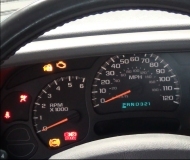You do not need a new engine. A lot of engines today are "interference" engines meaning when the timing belt breaks, or just jumps a few teeth, the open valves will be hit and bent by the pistons as they coast to a stop. When that happens, there's no ten percent chance nothing will be damaged.
Chrysler actually designed in a safeguard for this. When the timing belt jumps one tooth, the Engine Computer will detect it, set a diagnostic fault code, "Cam and Crank sync", and turn on the Check Engine light to tell you. At two teeth off, the computer will shut the engine down to protect the valves. At three teeth off is when the valves get bent. There are a number of fairly easy tests to identify a jumped timing belt as the cause of a no-start condition, but when someone keeps on trying to get the engine to run is when the belt typically jumps some more and the valve damage occurs anyway.
As for the mileage you listed, every manufacturer has a mileage at which you're supposed to have the belt replaced but a lot of people ignore that because the engine is running fine. In the late '80s, Honda used to recommend every 75,000 miles, and the belts typically broke at 65,000 miles. There were a lot of very unhappy owners because of that.
There's two things I should point out in to be sure you're aware. First of all, not all engines are of the interference design. The import manufacturers starting designing engines that way in the '80s to get more power out of a smaller engine. The domestic manufacturers had to do the same thing to be competitive, but it is a design I will never own for just the reason you're going through. My '88 Grand Caravan daily driver has a timing belt but the engine is not an interference engine. If my timing belt breaks, I just pop a new one on and off I go into the sunset.
The second thing I need to point out is that Check Engine light. Just because it turns on does not mean your timing belt has jumped a tooth as I might have implied. There are well over 2,000 potential diagnostic fault codes that can be set, and about half of them relate to things that could adversely affect emissions. Those are the codes that must turn on the Check Engine light. Most of the time the Check Engine light turns on due to failed sensor or a problem with its wiring, or because the computer detected an unacceptable operating condition, like "running lean too long" and things like that.
Once again, you do not need an entirely new engine. This is an all-too-common repair that affects some engines from every manufacturer in the world. The proper repair is to remove the cylinder head(s), replace the bent valves, reinstall the head with a new cylinder head gasket, then install the new timing belt.
You still didn't tell me which engine you have so I can't look up parts. If your water pump is driven by the timing belt, a conscientious mechanic is going to want to replace it at the same time if he has your best interest at heart. Failure of an old water pump will cause the same problem with the valves and you'll be going through the same repair again. There will also be other related parts that should be replaced along with the belt. Those include whatever is used to maintain tension on the belt. Typically that's a spring-loaded idler pulley but some engines use hydraulic tensioning devices.
At the very least the mechanic should explain why the water pump and tensioner should be replaced along with the timing belt, and let you make the final decision. As long as you understand that this is penny-wise and dollar-foolish. You might save a few dollars today but you risk another major failure and repair expense in the near future.
If a mechanic says you do not need to replace the water pump or tensioner, run as fast as you can to a different shop. That is, unless he knows your water pump was replaced recently. This type of mechanic thinks he's looking out for your wallet but he is just as misguided as an uninformed car owner. Some want to quote a lower repair estimate to undercut their competitors and get the job, then they "find out" later that the water pump is needed. It's also possible an inexperienced mechanic produced that lower estimate with the best of intentions, then got reprimanded by his boss who explained that you aren't going to be happy if you have more problems due to his short-sightedness.
At the mileage you listed you're past where some engines develop leaking cylinder head gaskets. That repair, which is also way too common in all car brands, encompasses about 90 percent of the work that your engine needs. Here again, no conscientious mechanic would not want to install a new timing belt right away as cheap insurance. He is going to already have the old one off, ... Why put it back on when the only additional cost is for the belt itself? And while you're getting mostly the same service, we don't replace the entire engine for that. If we replaced the engine every time a timing belt broke, half the cars on the road would have new engines in them.
Thursday, November 6th, 2014 AT 10:24 PM




